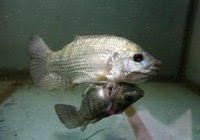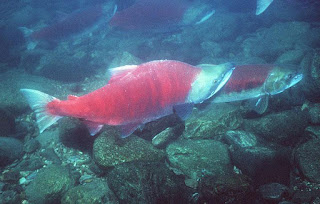Unusual Fish-Discoveries
UNUSUAL FISH AND NEW DISCOVERIES
Hundreds Of New Marine Species Discovered
 (AP) Marine scientists say they have discovered hundreds of new animal species on reefs in Australian waters, including brilliant soft corals and tiny crustaceans.
(AP) Marine scientists say they have discovered hundreds of new animal species on reefs in Australian waters, including brilliant soft corals and tiny crustaceans.A total of 274 species of fish, ancient corals, mollusks, crustaceans and sponges new to science were found in icy waters up to 3,000 meters (9,800 feet) deep among extinct volcanoes, they said. The scientists mapped undersea mountains up to 500 meters high and canyons larger than the Grand Canyon for the first time, the government's Commonwealth Scientific and Industrial Research Organization (CSIRO) said.
The creatures were found during expeditions run by the Australian chapter of CReefs, a global census of coral reefs that is one of several projects of the Census of Marine Life, an international effort to catalog all life in the oceans.
Among the creatures discovered were about 130 soft corals - also known as octocorals, for the eight tentacles that fringe each polyp - that have never been described in scientific literature, and scores of other crustaceans that have never been catalogued, including tiny shrimp-like animals with claws longer than their bodies.
(AP Photo/Gary Cranitch)
Conjoined Nile tilapia fish
(Click Pictures to enlarge)

These conjoined Nile tilapia fish swim in a Bangkok aquarium. They are eight months old and share a part of their stomachs. The bigger fish tends to protect the smaller one from harm, while the smaller one looks for food at the bottom of the aquarium.
 Nile tilapia can reach a maximum of two feet in length and can weigh up to nine pounds. Originally from waters stretching from Africa to the Cape Horn, the fish was introduced to freshwater irrigation systems so as to fight algae growth but has now become a pest.
Nile tilapia can reach a maximum of two feet in length and can weigh up to nine pounds. Originally from waters stretching from Africa to the Cape Horn, the fish was introduced to freshwater irrigation systems so as to fight algae growth but has now become a pest.The Nile Tilapia fish is a common freshwater species found in tropical rivers, canals, lakes and ponds but these two were found in a Bangkok aquarium.
Fish That Glow Red
(Click Picture to enlarge)
 This is a striking photo of a triplefin reef fluorescing red. According to new research, many reef animals glow red but that capacity is usually overlooked scientists because most of that wavelength of sunlight is absorbed out as you go more than 10 meters down into the ocean. As a result, most animals from that zone see blue light and green light best. But University of Tübingen evolution ecologist Nico Michiels and his colleagues suggest that the red-glowing fish carry an untold biological story about the spectrum of the sea. From Science News:
This is a striking photo of a triplefin reef fluorescing red. According to new research, many reef animals glow red but that capacity is usually overlooked scientists because most of that wavelength of sunlight is absorbed out as you go more than 10 meters down into the ocean. As a result, most animals from that zone see blue light and green light best. But University of Tübingen evolution ecologist Nico Michiels and his colleagues suggest that the red-glowing fish carry an untold biological story about the spectrum of the sea. From Science News: Michiels noticed the red fluorescence in 2007 while diving with a mask that filtered out all but red wavelengths for another project. As he descended, the sun's available red light dwindled quickly, leaving him in virtual darkness. Then he was startled to see the red fluorescent eyes of a fish, the red fin of another …. Since then, he and collaborators have found that 32 reef fishes sampled from 16 genera give off a red fluorescent glow. Substances on their bodies capture light at other wavelengths and release the energy as red light.
Most of the red-fluorescing fish are small and likely to have mates or neighbors close by, so red glows would make good short-range signals for courtship or other local business, Michiels suggests. The idea that seawater has rendered red ineffective "is a kind of dogma we are attacking," he says. "I would hope that the whole light ecology of reefs is reconsidered."
Sources:
Fish Glowing Red
| Recommended Aquatic Sites |
Premier Articles include Aquarium Lighting, Aquarium Chemistry; Calcium & more, etc. |
AQUARIUM AND POND ANSWERS with articles such as RO, Soft Water for Aquarium, PUR vs PAR in Aquarium Lighting or Aquarium Silicone Applications |
|
 |
Labels: Aquarium Lighting, Conjoined Nile tilapia fish, corals, discoveries, octocorals, stomachs














 Aquarium Lighting
Aquarium Lighting
 Reverse Osmosis Aquarium Water Filters
Reverse Osmosis Aquarium Water Filters